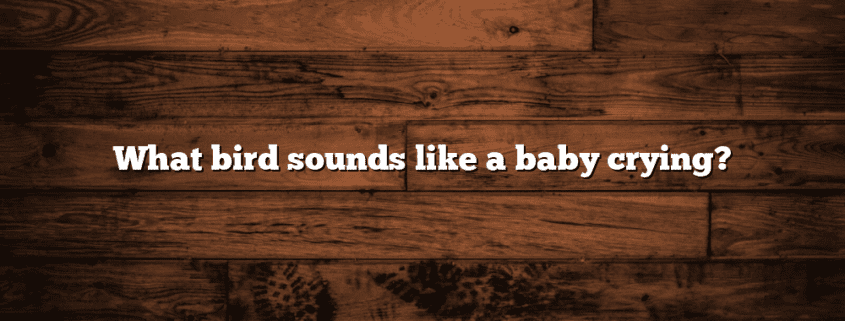What bird sounds like a baby crying?
What Bird Sounds Like a Baby Crying?
Have you ever been startled by a sound that resembles a baby crying, only to discover that it was actually a bird? Many people have experienced this puzzling phenomenon and wondered which bird could produce such a haunting sound. In this article, we will explore the bird species that mimic a baby’s cry and delve into the reasons behind their unique vocalizations.
The Gray Catbird: A Master of Mimicry
One bird species that is known for its ability to imitate a baby’s cry is the Gray Catbird (Dumetella carolinensis). These medium-sized songbirds are native to North America and are part of the Mimidae family, which includes mockingbirds and thrashers.
The Gray Catbird’s vocal repertoire is incredibly diverse, and they are skilled mimics of various sounds, including the cries of other birds, animals, and even human noises. Their ability to mimic a baby’s cry is particularly impressive, as they can produce a sound that is remarkably similar to that of a distressed infant.
Researchers believe that the Gray Catbird’s mimicry skills serve multiple purposes. One theory suggests that their ability to imitate a baby’s cry may help deter potential predators. By mimicking the sound of a vulnerable young animal, the Gray Catbird may trick predators into thinking that they are approaching a dangerous situation or a larger animal that could pose a threat.
Additionally, the Gray Catbird’s mimicry skills may also play a role in attracting mates. Male catbirds often incorporate various sounds into their songs, including the cries of other birds and animals. By showcasing their vocal range and ability to mimic different sounds, male catbirds may be signaling their fitness and genetic quality to potential mates.
Other Birds That Resemble a Baby’s Cry
While the Gray Catbird is perhaps the most well-known bird that sounds like a baby crying, there are other bird species that produce similar vocalizations. Here are a few examples:
- Black-billed Cuckoo (Coccyzus erythropthalmus): This bird, found in North America, is known for its distinctive call that resembles a baby crying. The sound is often described as a repetitive “coo-coo-coo” or “cuckoo-cuckoo.”
- Barn Owl (Tyto alba): While not a direct mimic of a baby’s cry, the screeching call of the Barn Owl can sometimes be mistaken for the sound of a distressed child. Their eerie vocalizations have earned them the nickname “screech owl.”
- Common Loon (Gavia immer): The haunting wails of the Common Loon are often compared to the sound of a crying baby. These calls are used for communication between individuals and can carry over long distances.
It is important to note that while these birds may produce sounds that resemble a baby’s cry, their vocalizations serve different purposes and are not necessarily an attempt to mimic human infants.
The Science Behind Bird Vocalizations
The ability of birds to mimic sounds, including a baby’s cry, is rooted in their unique vocal anatomy. Birds have a specialized vocal organ called the syrinx, located at the base of their trachea. Unlike humans, who produce sounds using their larynx, birds can produce complex vocalizations by manipulating the muscles and membranes of the syrinx.
Some bird species have evolved to have a highly developed syrinx, allowing them to produce a wide range of sounds and imitate various noises in their environment. This adaptation has likely evolved as a means of communication, attracting mates, and defending territories.
Conclusion
The world of bird vocalizations is a fascinating one, and the ability of certain species to mimic a baby’s cry is truly remarkable. The Gray Catbird, with its impressive mimicry skills, is often associated with this unique sound. However, other birds like the Black-billed Cuckoo, Barn Owl, and Common Loon also produce vocalizations that resemble a baby crying.
While the reasons behind these vocalizations may vary, they all serve important functions in the lives of these birds. Whether it is deterring predators, attracting mates, or communicating with other individuals, the ability to mimic a baby’s cry is just one example of the incredible diversity and adaptability of avian vocalizations.
So, the next time you hear a sound that resembles a baby crying, take a moment to appreciate the remarkable vocal abilities of our feathered friends. It is a testament to the wonders of nature and the intricate ways in which different species communicate and interact with their environment.




Leave a Reply
Want to join the discussion?Feel free to contribute!